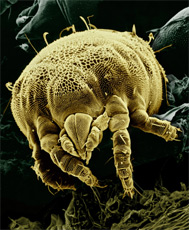
Type Lice
The erroneously named Type Louse is actually a mite, Pyroglyphidae Typographicus, whose closest relative is the common dust mite. Typographicus (right) has evolved to fill a niche which the dust mite could not – feeding on traces of organic matter amongst the fumes of white spirit and the dust of slowly oxidising type metal.
They're a pretty rare beast these days, but not yet extinct – you'll almost certainly have a few in your type cases. Invisible to the naked eye, the best way to detect them (without a microscope) is to hold a stethoscope to the wood and listen for a faint scratching sound.
There's no need to panic if you find a few infested cases, especially if they're stored in a chilly outbuilding. Professor Paul Legg of the Parasitology and Arachnology Dept., Quater Research Institute, Mass., offers some reassurance.
‘It is fortunate that the [American] letterpress revival is largely confined to our northern states where the Pyroglyphidae Typographicus population is kept in check by cold winter weather.’ In other words, we should be OK here in Britain.
 Comp Fever
Comp Fever
Despite what old comps may tell you, the lice (juvenile and fæces shown left) do not feed on type. Their fæces are slightly corrosive and it is this corrosion that, in the most severe infestations, can cause type to decay. ‘Comp Fever’ is thought to be an allergic reaction triggered by inhalation of these fæces. Reported symptoms include itching or burning sensations in the skin or eyes, sneezing, coughing and, in rare cases, gangrene.
Professor Legg's recent research has cast doubt on the physiological nature of the condition.
‘The first published account appears in The Printers Chronicle, an Australian trade journal, in 1956. It was picked up by relevant publications in both the US and UK. Several years later, The Crichton Medical Journal published an article by a certain Dr Bill Hartnell, describing Comp Fever or ‘Influenza Typographica’ as he named it.’
‘The article was criticised for its over reliance on anecdotal evidence and Dr Hartnell made no attempt to back-up his claims with clinical evidence. This controversy seems to have bypassed the printing industry, however, as by 1962 Comp Fever was the third most common reason given by compositors for unauthorised absences from work [in the US].’
The last recorded case of Comp Fever was in St. Eloi, France, in 1989. Will the recent letterpress resurgence resurrect the condition? Professor Legg doesn't think so. ‘We carried out a small study in 2004 in which 23 subjects were exposed to varying levels [of Typographicus fæces], and their immune response measured. The results showed average levels of histamines slightly below that of the control group.’ A trial on that scale may not be conclusive but, along with Hartnell's shaky science, it's enough to cast doubt over the conditions existence.
The professor goes on to state that he doesn't think that Comp Fever was psychosomatic, ‘Coinciding as it did with the hay-fever season, it seems likely that Influenza Typographica was a simple case of misdiagnosis.’
 Preventative Measures
Preventative Measures
In the 50s and 60s, the prescribed treatment was Dichlorodiphenyltrichloroethane (DDT) which is now banned in the UK and many other countries. In these more enlightened times, a natural alternative has been found.
Tricia McMillan of DANA Horticultural Sciences offers some advice. ‘There are many natural insect repellents available, including those based on neem or citronella, which seem to be effective in deterring Type Lice. But a cheaper alternative can be found in most gardens – lavender.’
‘We recommend using one small lavender bag per case of type. The natural oils lose their potency over time, so replace them once a year; preferably in early spring, so they're at their strongest during the breeding season.’
‘Lavender won't kill adult lice but it should help to keep the population levels down. The best thing about natural repellants like lavender is that unwelcome visitors like these won't build up resistance as they can to pesticides.’
Other Causes of Decay: A Word of Warning
Type Lice aren't likely to pose any real problems in your random, but the decay caused by lice can be confused with something more concerning. Seriously – old, improperly cast type can develop pitting on the body and a characteristic white-ish, powdery residue. This should be disposed of (or recast), the type case should be cleaned if possible and hands washed thoroughly.
You Might Also Like...
